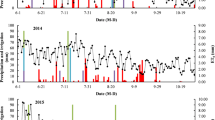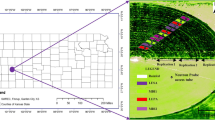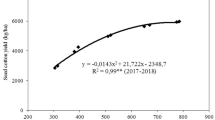Abstract
Transplanted short-season cotton followed by winter wheat is widely cultivated in the North China Plain (NCP). However, data and guidelines on irrigation water management for the short-season cotton cultivation are lacking. In order to determine optimal irrigation practices for transplanted cotton in the NCP, a field experiment with surface drip and border irrigation was conducted in 2011, 2012 and 2013 seasons. Four irrigation treatments, namely full drip (DT), full border (BT), deficit drip (DDT) and deficit border (DBT) irrigation treatments, were evaluated on the basis of vegetative growth, evapotranspiration (ET), cotton yield, water use efficiency (WUE) and fiber quality. Results showed that the average seasonal ET ranged from 358 to 449 mm. Compared to the border irrigation, the drip irrigation improved vegetative growth, and the deficit irrigation inhibited vegetative growth compared with the full irrigation. DT produced the highest seed cotton yield of 3164 kg ha−1, while the minimum seed cotton yield of 2459 kg ha−1 was produced in the DBT. On average, DDT produced the largest WUE of 0.83 kg m−3, while the smallest in BT. On average, 33.4 % of the irrigation water was saved by DT compared to BT, and drip irrigation increased seed cotton yield by 11.5 %. In addition, drip irrigation tended to increase the fiber length and optimize the micronaire value. Deficit irrigation significantly decreased the fiber strength and reduced the fiber length. Overall, the DT is recommended as the optimal irrigation strategy for the short-season cotton in the NCP.




Similar content being viewed by others
References
Allen RG, Pereira LS, Raes D, Smith M (1998) Crop evapotranspiration guidelines for computing crop water requirements. Irrigation and drainage paper, Paper 56. FAO, Rome
Aujla S, Thind HS, Butter GS (2005) Cotton yield and water use efficiency at various levels of water and N through drip irrigation under two methods of planting. Agric Water Manag 71:167–179
Bonachela S, Orgaz F, Villalobos FJ, Fereres E (2001) Soil evaporation from drip-irrigated olive orchards. Irrig Sci 20:65–71
Cetin O, Bilgel L (2002) Effects of different irrigation methods on shedding and yield of cotton. Agric Water Manag 54:1–15
Chen Z, Wang J, Song N (2012) Application of GIS spatial analysis to measure leaf area of cotton. Chin Agric Sci Bull 28(9):145–149 (in Chinese)
Constable GA, Hodgson AS (1990) A comparison of drip and furrow irrigated cotton on a cracking clay soil. Irrig Sci 11:149–153
Dağdelen N, Başal H, Yılmaz E, Gürbüz T, Akçay S (2009) Different drip irrigation regimes affect cotton yield, water use efficiency and fiber quality in western Turkey. Agric Water Manag 96:111–120
Dong H, Li W, Tang W, Li Z, Zhang D, Niu Y (2006) Yield, quality and leaf senescence of cotton grown at varying planting dates and plant densities in the Yellow River Valley of China. Field Crops Res 98:106–115
Du T, Kang S, Zhang J, Li F (2008) Water use and yield responses of cotton to alternate partial root-zone drip irrigation in the arid area of north-west China. Irrig Sci 26:147–159
Ertek A, Kanber R (2003) Effects of different drip irrigation programs on the boll number and shedding percentage and yield of cotton. Agric Water Manag 60:1–11
Fang W, Xie D, Li W, Ma Z, Li L (2011) Studies on bolls spatial and temporal distribution and yield of short-season cotton under different planting densities. J Henan Agric Sci 40(1):58–61 (in Chinese)
Farahani HJ, Oweis TY, Izzi G (2008) Crop coefficient for drip-irrigated cotton in a Mediterranean environment. Irrig Sci 26:375–383
Gao Y, Shen X, Li X, Meng Z, Sun J, Duan A (2015) Effects of pre-sowing irrigation on crop water consumption, grain yield and water productivity of winter wheat in the North China Plain. Irrig Drain 64:566–574
Guan H, Li J, Li Y (2013) Effects of drip system uniformity and irrigation amount on cotton yield and quality under arid conditions. Agric Water Manag 124:37–51
Hanson BR, May DM (2006) Crop coefficients for drip-irrigation processing tomato. Agric Water Manag 81:381–399
Hanson BR, Hutmacher RB, May DM (2006) Drip irrigation of tomato and cotton under shallow saline ground water conditions. Irrig Drain Syst 20:155–175
Hatfield JL, Boote KJ, Kimball BA, Ziska LH, Izaurralde RC, Ort D, Thomson AM, Wolfe D (2011) Climate impacts on agriculture: implications for crop production. Agron J 103:351–370
Hillel D (1998) Environmental soil physics. Academics Press, London
Howell TA, Meron M, Davis KR, Phene CJ, Yamada H (1989) Water management of trickle and furrow irrigated narrow row cotton in the San Joaquin Valley. Soil Fertil 52:1–4
Ibragimov N, Evett SR, Esanbekov Y, Kamilov BS, Mirzaev L, Lamers JPA (2007) Water use efficiency of irrigation cotton in Uzbekistan under drip and furrow irrigation. Agric Water Manag 90:112–120
Jalota SK, Sood A, Chahal GBS, Chouodhury BU (2006) Crop water productivity of cotton (Gossypium hirsutum L.)–wheat (Triticum aestivum L.) system as influenced by deficit irrigation, soil texture and precipitation. Agric Water Manag 84:137–146
Johnson RM, Downer RG, Bradow JM, Bauer PJ, Sadler EJ (2002) Variability in cotton fiber yield, fiber quality, and soil properties in a southeastern coastal plain. Agron J 94:1305–1316
Kang Y, Wang F, Liu H, Yuan B (2004) Potato evapotranspiration and yield under different drip irrigation regimes. Irrig Sci 23:133–143
Kang Y, Wang R, Hu W, Jiang S, Liu S (2012) Effects of different water levels on cotton growth and water use through drip irrigation in an arid region with saline ground water of Northwest China. Agric Water Manag 109:117–126
Liu X, Mao S, Han Y, Li Y, Fang Z, Wang G, Feng L, Dong C, Zhu Q (2010) Study on physiological and biochemical indicators of seedling of three new seedling-raising and transplanting methods at recovering stage. Cotton Sci 22(5):437–442 (in Chinese)
Liu H, Sun J, Zhang J, Wang C, Yue J, Zhang J, Shen X (2011) Effect of tillage methods and water treatment on production and water use of cotton. Trans CSAE 27(10):98–105 (in Chinese)
Liu H, Sun J, Zhang J, Zhang J, Shen X (2012) Effects of tillage mode and deficit irrigation on the yield and water use of transplanted cotton following wheat harvest under sprinkler irrigation. Chin J Appl Econ 23(2):389–394 (in Chinese)
Ma X, Wu X, Su Y, Wang H (2004) Analysis on several problems of drip irrigation development in China. Water Sav Irrig 7:21–23 (in Chinese)
Ma Q, Wang Z, Cui X, Hao J, Du X (2010) Comparison of comprehensive benefit between transplanted cotton following wheat harvest and wheat–cotton intercropping system. J Henan Agric Sci 4:26–28 (in Chinese)
Mao S (2013) Cotton cultivation of China. Shanghai Scientific and Technical Publishers, Shanghai, pp 750–756 (in Chinese)
Mao S, Dong J (2003) High quality cotton varieties and cultivation techniques. China Agriculture Press, Beijing, pp 9–14 (in Chinese)
Mateos L, Berengena J, Orgaz F, Diz J, Fereres E (1991) A comparison between drip and furrow irrigation in cotton at two levels of water supply. Agric Water Manag 19:313–324
Önder D, Akiscan Y, Önder S, Mert M (2009) Effect of different irrigation water level on cotton yield and yield components. Afr J Biotechnol 8(8):1536–1544
Pettigrew WT (2004) Moisture deficit effects on cotton lint yield components, and boll distribution. Agron J 96:377–383
Reddy KR, Prasad PVV, Kakani VG (2005) Crop responses to elevated carbon dioxide and interactions with temperature. Cotton J Crop Improv 13:157–191
Sawan ZM (2009) Response of flower and boll development to climatic factors in Egyptian cotton. Clim Change 97:553–591
Sawan ZM, Hanna LI, McCuistion WL, Foote RJ (2010) Egyptian cotton (Gossypium barbadense) flower and boll production as affected by climatic factors and soil moisture status. Theor Appl Climatol 99:217–227
Smith RB, Oster JD, Phene JC (1991) Subsurface drip irrigation produced highest net return in wasteland area study. Calif Agric 45(2):8–10
Snowden C, Ritchie G, Cave J, Keeling W, Rajan N (2013) Multiple irrigation levels affect boll distribution, yield, and fiber micronaire in cotton. Agron J 105:1536–1544
SPSS (2007) SPSS brief guide 16.0. SPSS Inc
Standard C (2007) Chinese National Standard, GB 1103-2007: Cotton-Upland cotton. Standards Press of China, Beijing (in Chinese)
Thompson TL, Pang H, Li Y (2009) The potential contribution of subsurface drip irrigation to water-saving agriculture in the Western USA. Agric Sci China 8(7):850–854
Ünlü M, Kanber R, Koç DL, Tekin S, Kapur B (2011) Effect of deficit irrigation on the yield and yield components of drip irrigated cotton in a Mediterranean environment. Agric Water Manag 98:597–605
Van Genutchen MT (1980) A closed-form equation for predicting the hydraulic conductivity of unsaturated soils. Soil Sci Soc Am J 44:892–898
Wang C, Akihiroz I, Li M, Wang D (2007) Growth and eco-physiological performance of cotton under water stress conditions. Agric Sci China 6(8):949–955
Wang Z, Ma Q, Luan D, Liu L, Yao H (2010) Comparison of comprehensive benefit of transplanting cotton after wheat harvest and wheat cotton intercropping. J Hebei Agric Sci 14(7):97–98 (in Chinese)
Wang G, Han Y, Mao S, Fang Z, Feng L, Li Y (2011) Effects of seedling ages on growth, development and yield of transplanted short season cotton in wheat–cotton continuous cropping pattern. Cotton Sci 23(6):573–580 (in Chinese)
Yazar A, Sezen SM, Sesveren S (2002) LEPA and trickle irrigation of cotton in the Southeast Anatolia Project (GAP) area in Turkey. Agric Water Manag 54:189–203
Zhang X, Pei D, Chen S, Sun H, Yang Y (2006) Performance of double-cropped winter wheat–summer maize under minimum irrigation in the North China Plain. Agron J 98:1620–1626
Acknowledgments
We acknowledge the financial support from the China Agriculture Research System (CARS-18-19), the Special Fund for Agro-Scientific Research in the Public Interest (201203077) and the Special Fund in the Public Interest of Ministry of Water Resources (201501017).
Author information
Authors and Affiliations
Corresponding author
Additional information
Communicated by S. O. Shaughnessy.
Rights and permissions
About this article
Cite this article
Liu, H., Gao, Y., Sun, J. et al. Responses of yield, water use efficiency and quality of short-season cotton to irrigation management: interactive effects of irrigation methods and deficit irrigation. Irrig Sci 35, 125–139 (2017). https://doi.org/10.1007/s00271-016-0526-4
Received:
Accepted:
Published:
Issue Date:
DOI: https://doi.org/10.1007/s00271-016-0526-4




